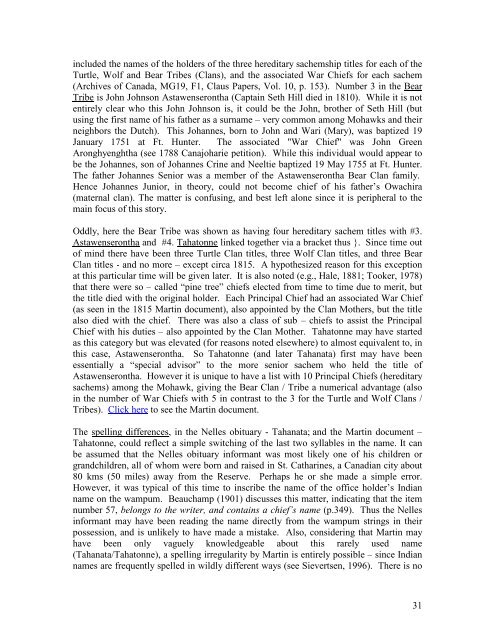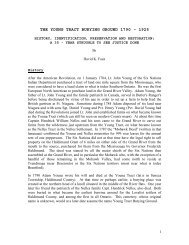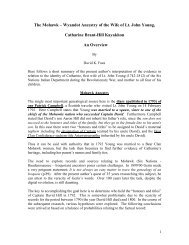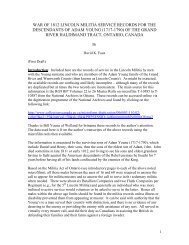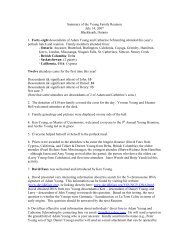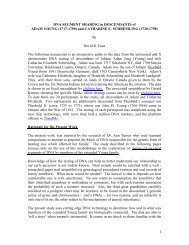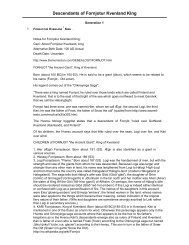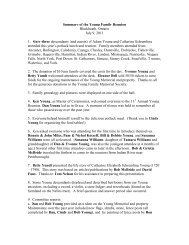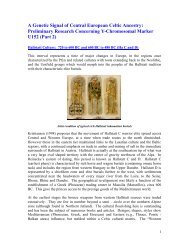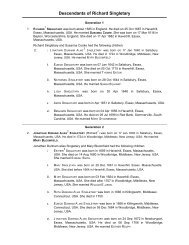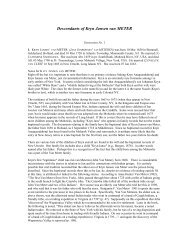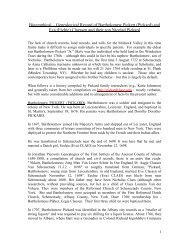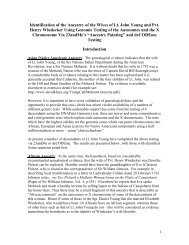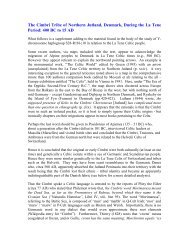Mohawk â Wyandot Ancestry of Lt. John Young's ... - Davidkfaux.org
Mohawk â Wyandot Ancestry of Lt. John Young's ... - Davidkfaux.org
Mohawk â Wyandot Ancestry of Lt. John Young's ... - Davidkfaux.org
- No tags were found...
Create successful ePaper yourself
Turn your PDF publications into a flip-book with our unique Google optimized e-Paper software.
included the names <strong>of</strong> the holders <strong>of</strong> the three hereditary sachemship titles for each <strong>of</strong> theTurtle, Wolf and Bear Tribes (Clans), and the associated War Chiefs for each sachem(Archives <strong>of</strong> Canada, MG19, F1, Claus Papers, Vol. 10, p. 153). Number 3 in the BearTribe is <strong>John</strong> <strong>John</strong>son Astawenserontha (Captain Seth Hill died in 1810). While it is notentirely clear who this <strong>John</strong> <strong>John</strong>son is, it could be the <strong>John</strong>, brother <strong>of</strong> Seth Hill (butusing the first name <strong>of</strong> his father as a surname – very common among <strong>Mohawk</strong>s and theirneighbors the Dutch). This Johannes, born to <strong>John</strong> and Wari (Mary), was baptized 19January 1751 at Ft. Hunter. The associated "War Chief" was <strong>John</strong> GreenAronghyenghtha (see 1788 Canajoharie petition). While this individual would appear tobe the Johannes, son <strong>of</strong> Johannes Crine and Neeltie baptized 19 May 1755 at Ft. Hunter.The father Johannes Senior was a member <strong>of</strong> the Astawenserontha Bear Clan family.Hence Johannes Junior, in theory, could not become chief <strong>of</strong> his father’s Owachira(maternal clan). The matter is confusing, and best left alone since it is peripheral to themain focus <strong>of</strong> this story.Oddly, here the Bear Tribe was shown as having four hereditary sachem titles with #3.Astawenserontha and #4. Tahatonne linked together via a bracket thus }. Since time out<strong>of</strong> mind there have been three Turtle Clan titles, three Wolf Clan titles, and three BearClan titles - and no more – except circa 1815. A hypothesized reason for this exceptionat this particular time will be given later. It is also noted (e.g., Hale, 1881; Tooker, 1978)that there were so – called “pine tree” chiefs elected from time to time due to merit, butthe title died with the original holder. Each Principal Chief had an associated War Chief(as seen in the 1815 Martin document), also appointed by the Clan Mothers, but the titlealso died with the chief. There was also a class <strong>of</strong> sub – chiefs to assist the PrincipalChief with his duties – also appointed by the Clan Mother. Tahatonne may have startedas this category but was elevated (for reasons noted elsewhere) to almost equivalent to, inthis case, Astawenserontha. So Tahatonne (and later Tahanata) first may have beenessentially a “special advisor” to the more senior sachem who held the title <strong>of</strong>Astawenserontha. However it is unique to have a list with 10 Principal Chiefs (hereditarysachems) among the <strong>Mohawk</strong>, giving the Bear Clan / Tribe a numerical advantage (alsoin the number <strong>of</strong> War Chiefs with 5 in contrast to the 3 for the Turtle and Wolf Clans /Tribes). Click here to see the Martin document.The spelling differences, in the Nelles obituary - Tahanata; and the Martin document –Tahatonne, could reflect a simple switching <strong>of</strong> the last two syllables in the name. It canbe assumed that the Nelles obituary informant was most likely one <strong>of</strong> his children <strong>org</strong>randchildren, all <strong>of</strong> whom were born and raised in St. Catharines, a Canadian city about80 kms (50 miles) away from the Reserve. Perhaps he or she made a simple error.However, it was typical <strong>of</strong> this time to inscribe the name <strong>of</strong> the <strong>of</strong>fice holder’s Indianname on the wampum. Beauchamp (1901) discusses this matter, indicating that the itemnumber 57, belongs to the writer, and contains a chief’s name (p.349). Thus the Nellesinformant may have been reading the name directly from the wampum strings in theirpossession, and is unlikely to have made a mistake. Also, considering that Martin mayhave been only vaguely knowledgeable about this rarely used name(Tahanata/Tahatonne), a spelling irregularity by Martin is entirely possible – since Indiannames are frequently spelled in wildly different ways (see Sievertsen, 1996). There is no31


